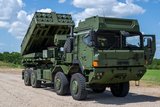Raytheon working on Subterranean Surveillance project
Raytheon is working on a DARPA Subterranean Surveillance project to create new methods for detecting buried explosives using synthetic biology.
Under its DARPA contract, Raytheon is working with Worcester Polytechnic Institute to programme two bacterial strains to monitor ground surfaces for explosive materials.
The first strain will detect the presence or absence of explosives buried underground. If the first strain detects explosives, the second strain will produce a glowing light on the ground's surface. Remote cameras or UAS can then be used to survey large areas for the tell-tale luminescence.
The Subterranean Surveillance programme is one example in which advances in synthetic biology are being used to develop sensors that can reveal a variety of subterranean phenomena at a distance. Synthetic biology combines principles of electrical engineering with computer science to modify DNA.
Allison Taggart, principal investigator for the Bio Reporters for Subterranean Surveillance program at Raytheon BBN Technologies, said: ‘We already know that some bacteria can be programmed to be very good at detecting explosives, but it's harder underground. We're investigating how to transport the reporting bacteria to the required depth underground, and then pushing the luminescence up to the surface so it's easily visible.
‘Using bio sensors underground could help us save lives as well as detect threats to air quality and the water supply. The modular design of the system we're developing will allow us to swap in different components as needed to detect various kinds of threats and contaminants.’
More from Land Warfare
-
![Hungary set to begin using Hero 400 loitering munitions]()
Hungary set to begin using Hero 400 loitering munitions
Developed by Israel's Uvision and with systems being sold in the thousands to multiple European NATO countries and the US, the Hero family of loitering systems is also in production in the US and Italy, the latter through Rheinmetall.
-
![Croatia orders Leopards and CAESAR howitzers as Lithuania orders more CAESARs]()
Croatia orders Leopards and CAESAR howitzers as Lithuania orders more CAESARs
The Leopard is becoming the tank of choice in central and eastern Europe as Croatia joins Lithuania, the Czech Republic and Hungary in ordering the platform. Lithuania and Croatia have also signed for CAESAR howitzers.
-
![Light Reconnaissance Strike – enabling a vital mission set (Studio)]()
Light Reconnaissance Strike – enabling a vital mission set (Studio)
A new system-of-systems concept will unlock digital integration of sensors and weapons for Light Forces, allowing them to shape the battlefield environment on their own terms and upgrade legacy platforms.
-
![Lockheed Martin to look further afield for GMARS rocket system opportunities]()
Lockheed Martin to look further afield for GMARS rocket system opportunities
The HX truck is already in use in many NATO and allied countries around the world as a logistics vehicle and carrier for high-value systems, including missile firing weapons, so its use for the Global Mobile Artillery Rocket System makes logistical sense.
-
![Lithuanian 1st Division to achieve initial operating capability in 2026]()
Lithuanian 1st Division to achieve initial operating capability in 2026
Lithuania is one of the countries stepping up its defences in the face of the war in Ukraine with a particular focus on its neighbour and Russian ally Belarus, which has been making incursions into Lithuania’s airspace with balloons and drones.
-
Medium knocked out of British Army LMP, with CAVS as heavyweight champion
As the British Army seeks to modernise and consolidate its diverse vehicle fleet, yet another change in direction is underway.


























